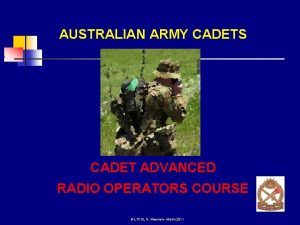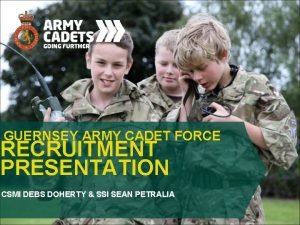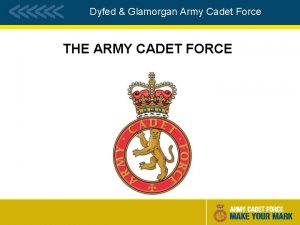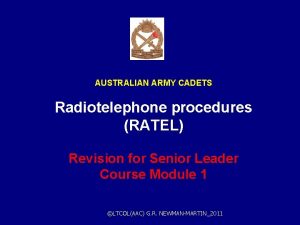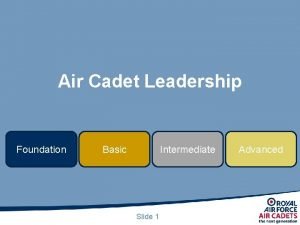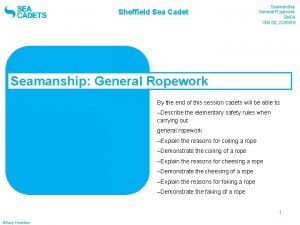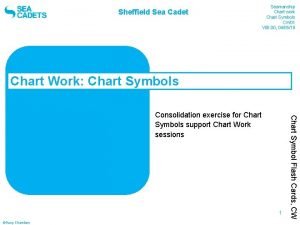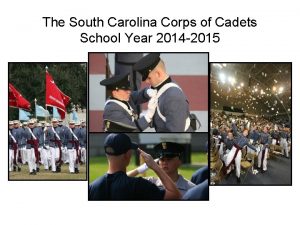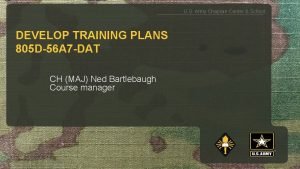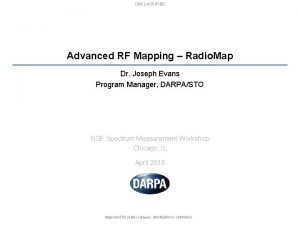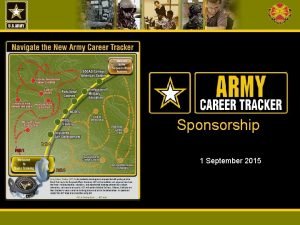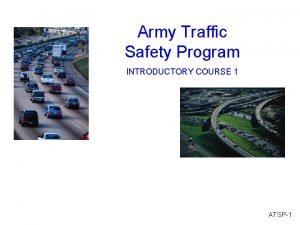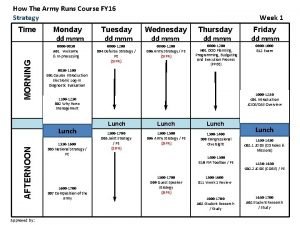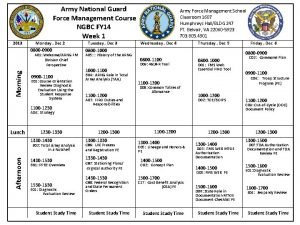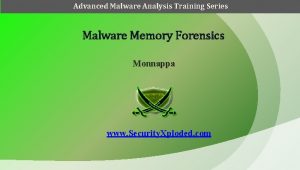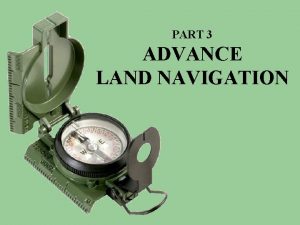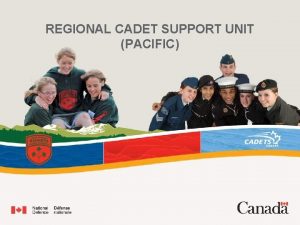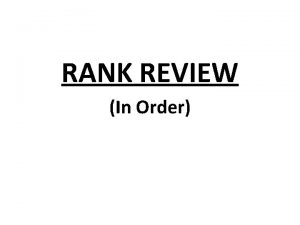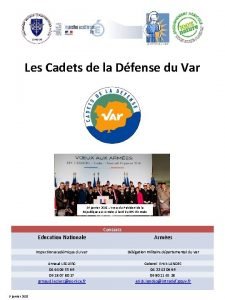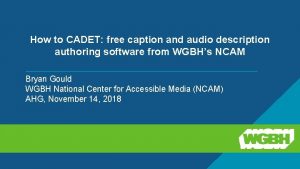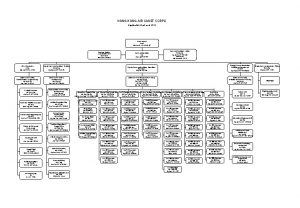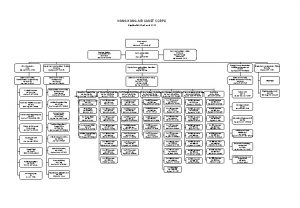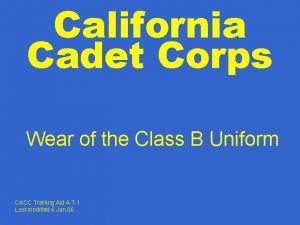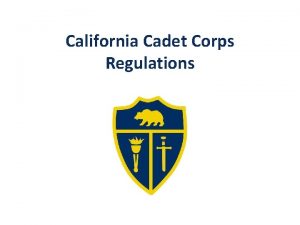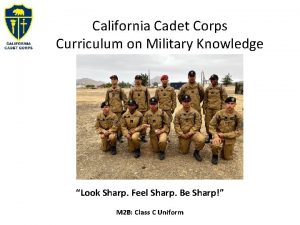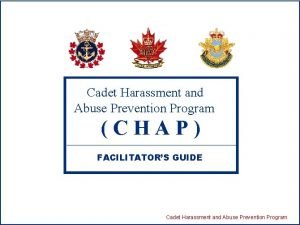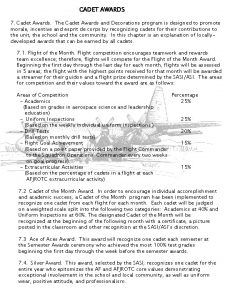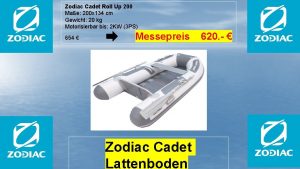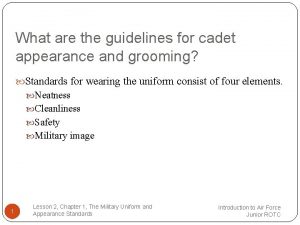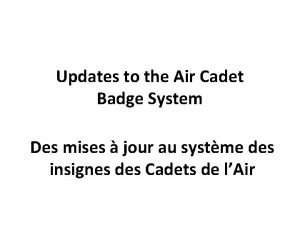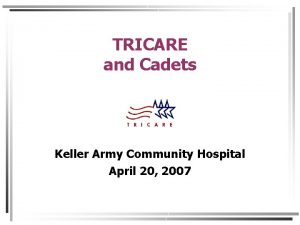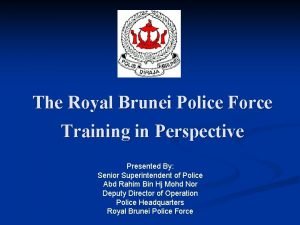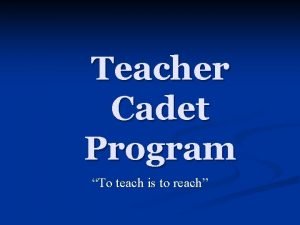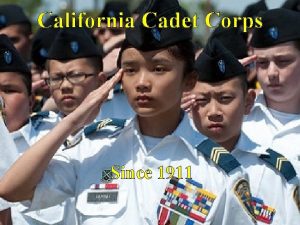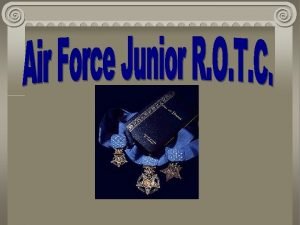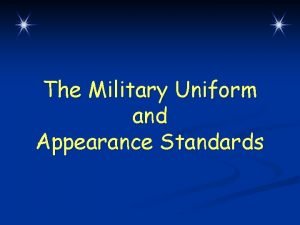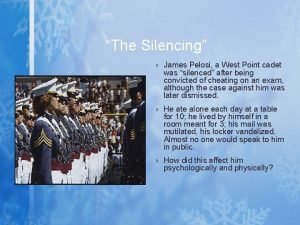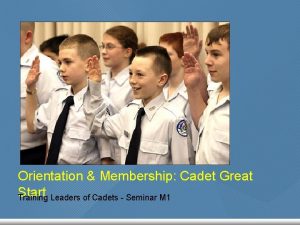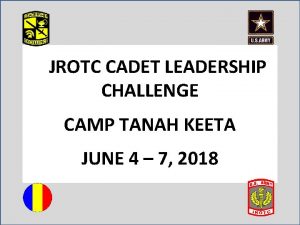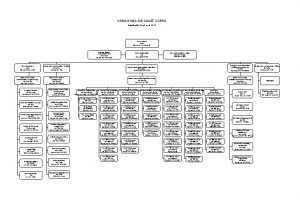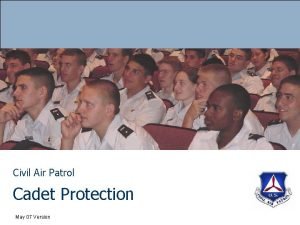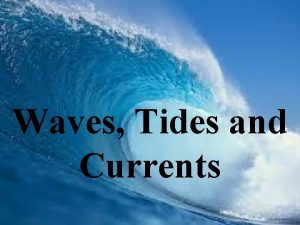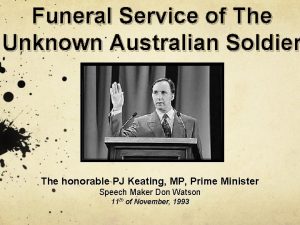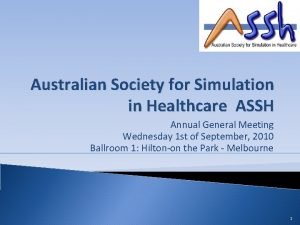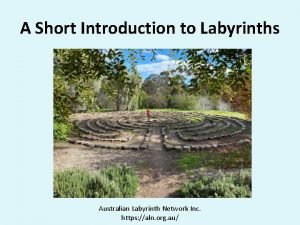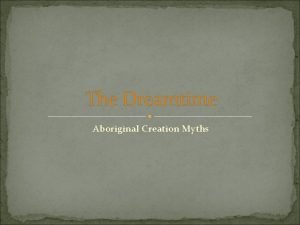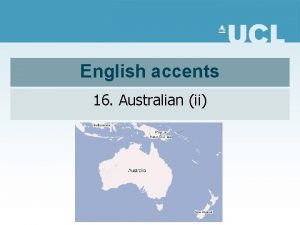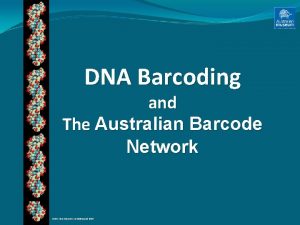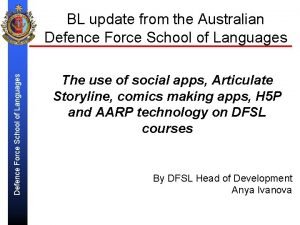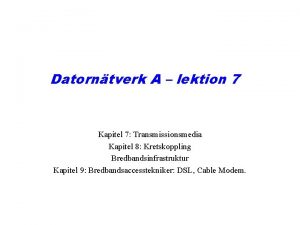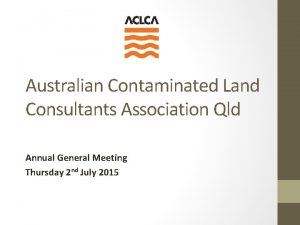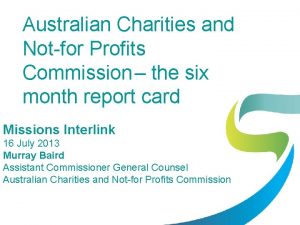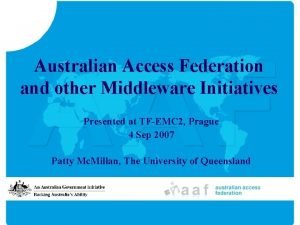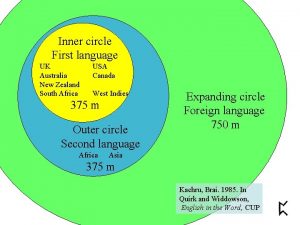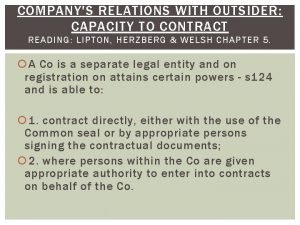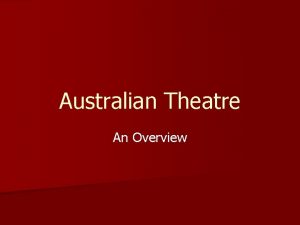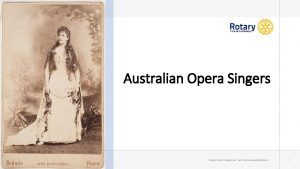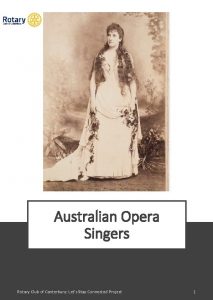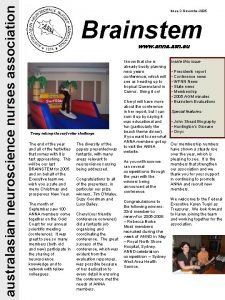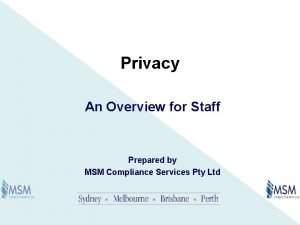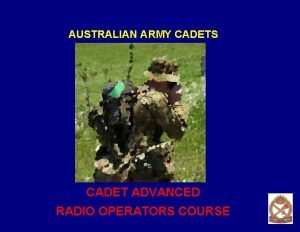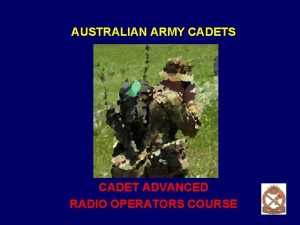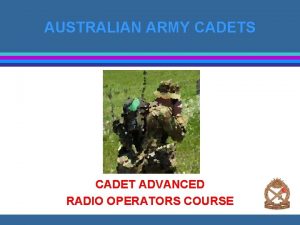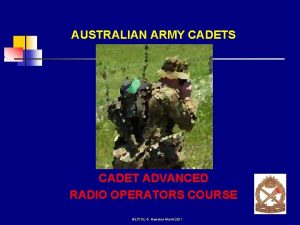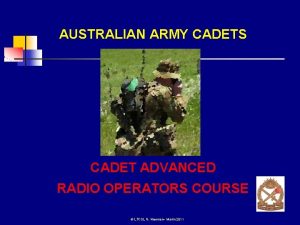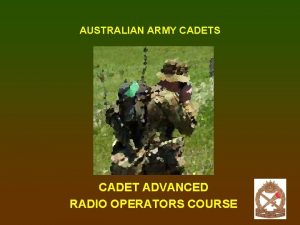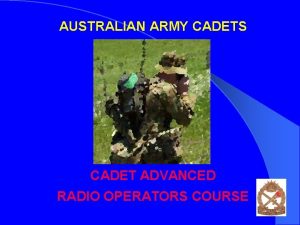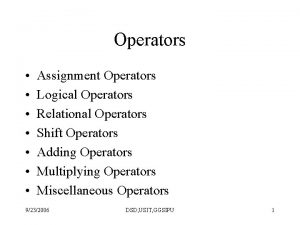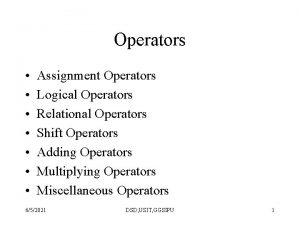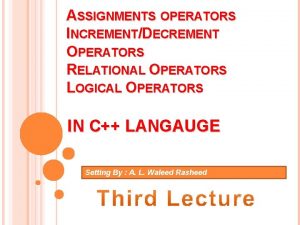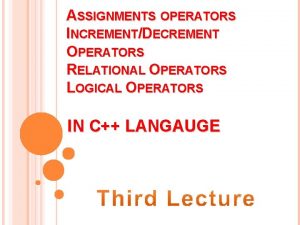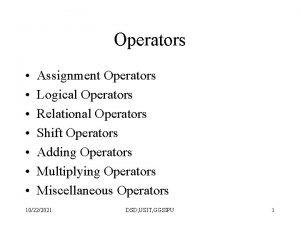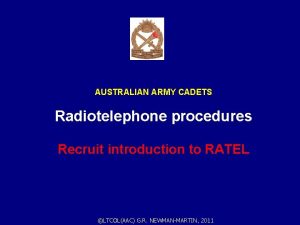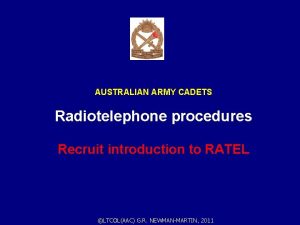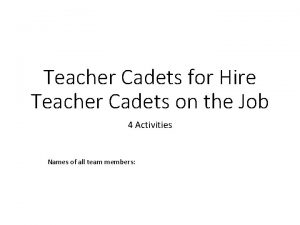AUSTRALIAN ARMY CADETS CADET ADVANCED RADIO OPERATORS COURSE














































































































































- Slides: 142

AUSTRALIAN ARMY CADETS CADET ADVANCED RADIO OPERATORS COURSE

Command Post Radio Operator’s Course ©LTCOL G. Newman-Martin 2011

Topic 5 ©LTCOL G. Newman-Martin 2011

Establishing Communications ©LTCOL G. Newman-Martin 2011

Phases of opening a net ©LTCOL G. Newman-Martin 2011

Phases of opening a net • Preliminary instructions ©LTCOL G. Newman-Martin 2011

Phases of opening a net • Preliminary instructions • Initial calls ©LTCOL G. Newman-Martin 2011

Phases of opening a net • Preliminary instructions • Initial calls • Amplifying reports ©LTCOL G. Newman-Martin 2011

Phases of opening a net Preliminary instructions ©LTCOL G. Newman-Martin 2011

Before the net opens all operators must be supplied with preliminary instructions regarding the working of the net. ©LTCOL G. Newman-Martin 2011

©LTCOL G. Newman-Martin 2011

SIGNAL OPERATING INSTRUCTIONS (SOI's) ©LTCOL G. Newman-Martin 2011

Preliminary instructions are contained in Signal Operating instructions (SOIs) ©LTCOL G. Newman-Martin 2011

Signal Operating Instructions (SOIs) • net organization ©LTCOL G. Newman-Martin 2011

Signal Operating Instructions (SOIs) • net organization - net diagram and/or list of stations + callsigns ©LTCOL G. Newman-Martin 2011

Signal Operating Instructions (SOIs) • net organization - net diagram and/or list of stations + callsigns • frequencies ©LTCOL G. Newman-Martin 2011

Signal Operating Instructions (SOIs) • net organization - net diagram and/or list of stations + callsigns • frequencies • collective callsigns ©LTCOL G. Newman-Martin 2011

Signal Operating Instructions (SOIs) • net organization - net diagram and/or list of stations + callsigns • frequencies • collective callsigns • net identification callsign ©LTCOL G. Newman-Martin 2011

Signal Operating Instructions (SOIs) • net organization - net diagram and/or list of stations + callsigns • frequencies • collective callsigns • net identification callsign • codes ©LTCOL G. Newman-Martin 2011

Signal Operating Instructions (SOIs) • net organization - net diagram and/or list of stations + callsigns • frequencies • collective callsigns • net identification callsign • codes • code words and nicknames ©LTCOL G. Newman-Martin 2011

Signal Operating Instructions (SOIs) • net organization - net diagram and/or list of stations + callsigns • frequencies • collective callsigns • net identification callsign • codes • code words and nicknames • time net is to open ©LTCOL G. Newman-Martin 2011

Signal Operating Instructions (SOIs) • net organization - net diagram and/or list of stations + callsigns • frequencies • collective callsigns • net identification callsign • codes • code words and nicknames • time net is to open • net security measures ©LTCOL G. Newman-Martin 2011

Signal Operating Instructions (SOIs) • SOIs change daily ©LTCOL G. Newman-Martin 2011

Signal Operating Instructions (SOIs) • SOIs change daily • One days’s SOIs per page ©LTCOL G. Newman-Martin 2011

Signal Operating Instructions (SOIs) • SOIs change daily • One days’s SOIs per page • Maximum of 7 days pages carried at . . any one time ©LTCOL G. Newman-Martin 2011

Signal Operating Instructions (SOIs) LAYOUT ©LTCOL G. Newman-Martin 2011

Signal Operating Instructions (SOIs) LAYOUT • Booklet – 4 main parts: ©LTCOL G. Newman-Martin 2011

Signal Operating Instructions (SOIs) LAYOUT • Booklet – 4 main parts: • User’s name group ©LTCOL G. Newman-Martin 2011

Signal Operating Instructions (SOIs) LAYOUT • Booklet – 4 main parts: • User’s name group • Frequency groups and frequency designator allocations ©LTCOL G. Newman-Martin 2011

Signal Operating Instructions (SOIs) LAYOUT • Booklet – 4 main parts: • User’s name group • Frequency groups and frequency designator allocations • Callsign allocation group ©LTCOL G. Newman-Martin 2011

Signal Operating Instructions (SOIs) LAYOUT • Booklet – 4 main parts: • User’s name group • Frequency groups and frequency designator allocations • Callsign allocation group • Nickname allocation

Signal Operating Instructions (SOIs) User’s name group ©LTCOL G. Newman-Martin 2011

Signal Operating Instructions (SOIs) User’s name group • usually at top of SOI ©LTCOL G. Newman-Martin 2011

Signal Operating Instructions (SOIs) User’s name group • usually at top of SOI • user’s unit and date-time group (DTG) ©LTCOL G. Newman-Martin 2011

Signal Operating Instructions (SOIs) User’s name group • usually at top of SOI • user’s unit and date-time group (DTG) • indicates net type (e. g. COMD or ADMIN) ©LTCOL G. Newman-Martin 2011

Signal Operating Instructions (SOIs) Frequency groups ©LTCOL G. Newman-Martin 2011

Signal Operating Instructions (SOIs) Frequency groups • priority (PRI) frequency ©LTCOL G. Newman-Martin 2011

Signal Operating Instructions (SOIs) Frequency groups • priority (PRI) frequency • alternate (ALT) frequency ©LTCOL G. Newman-Martin 2011

Signal Operating Instructions (SOIs) Frequency groups • priority (PRI) frequency • alternate (ALT) frequency • designator allocation – i. e. nickname – for each allocation ©LTCOL G. Newman-Martin 2011

Signal Operating Instructions (SOIs) Callsign allocation group ©LTCOL G. Newman-Martin 2011

Signal Operating Instructions (SOIs) Callsign allocation group • net callsign ©LTCOL G. Newman-Martin 2011

Signal Operating Instructions (SOIs) Callsign allocation group • net callsign • collective callsigns ©LTCOL G. Newman-Martin 2011

Signal Operating Instructions (SOIs) Nickname allocation ©LTCOL G. Newman-Martin 2011

Signal Operating Instructions (SOIs) Nickname allocation • for change of frequencies ©LTCOL G. Newman-Martin 2011

Signal Operating Instructions (SOIs) Nickname allocation • for change of frequencies • to countermand order ©LTCOL G. Newman-Martin 2011

EXAMPLE OF SOI – PAGE 1 ©LTCOL G. Newman-Martin 2011

EXAMPLE OF SOI – PAGE 2 ©LTCOL G. Newman-Martin 2011

INITIAL CALLS ©LTCOL G. Newman-Martin 2011

INITIAL CALLS • at time designated for opening of net, NCS makes an ‘initial call’ to all stations ©LTCOL G. Newman-Martin 2011

INITIAL CALLS • at time designated for opening of net, NCS makes an ‘initial call’ to all stations • NCS uses proword ‘RADIO CHECK’ ©LTCOL G. Newman-Martin 2011

INITIAL CALLS • at time designated for opening of net, NCS makes ‘initial call’ to all stations • NCS uses proword ‘RADIO CHECK’ • RADIO CHECK means ‘what is my RADIO CHECK signal strength & readability? ’ ©LTCOL G. Newman-Martin 2011

INITIAL CALLS • Substations then reply in correct answering order, stating how they hear the NCS. ©LTCOL G. Newman-Martin 2011

SIGNAL STRENGTH PROWORDS – INITIAL CALL • Substations use these prowords to report signal . . . strength: ©LTCOL G. Newman-Martin 2011

SIGNAL STRENGTH PROWORDS – INITIAL CALL • Substations use these prowords to report signal . . . strength: • LOUD ©LTCOL G. Newman-Martin 2011

SIGNAL STRENGTH PROWORDS – INITIAL CALL • Substations use these prowords to report signal . . . strength: • LOUD Your signal strength is excellent ©LTCOL G. Newman-Martin 2011

SIGNAL STRENGTH PROWORDS – INITIAL CALL • Substations use these prowords to report signal . . . strength: • LOUD • GOOD Your signal strength is excellent ©LTCOL G. Newman-Martin 2011

SIGNAL STRENGTH PROWORDS – INITIAL CALL • Substations use these prowords to report signal. . . strength: • LOUD • GOOD Your signal strength is excellent Your signal strength is good ©LTCOL G. Newman-Martin 2011

SIGNAL STRENGTH PROWORDS – INITIAL CALL • Substations use these prowords to report signal. . . strength: • LOUD • GOOD • WEAK Your signal strength is excellent Your signal strength is good ©LTCOL G. Newman-Martin 2011

SIGNAL STRENGTH PROWORDS – INITIAL CALL • Substations use these prowords to report signal. . . strength: • LOUD • GOOD • WEAK Your signal strength is excellent Your signal strength is good Your signal strength is weak ©LTCOL G. Newman-Martin 2011

SIGNAL STRENGTH PROWORDS – INITIAL CALL • Substations use these prowords to report signal. . . strength: • LOUD Your signal strength is excellent • GOOD Your signal strength is good • WEAK Your signal strength is weak • VERY WEAK ©LTCOL G. Newman-Martin 2011

SIGNAL STRENGTH PROWORDS – INITIAL CALL • Substations use these prowords to report signal. . . strength: • LOUD Your signal strength is excellent • GOOD Your signal strength is good • WEAK Your signal strength is weak • VERY WEAK Your signal strength is very weak ©LTCOL G. Newman-Martin 2011

SIGNAL STRENGTH PROWORDS – INITIAL CALL • Substations use these prowords to report signal. . . strength: • LOUD Your signal strength is excellent • GOOD Your signal strength is good • WEAK Your signal strength is weak • VERY WEAK Your signal strength is very weak • FADING ©LTCOL G. Newman-Martin 2011

SIGNAL STRENGTH PROWORDS – INITIAL CALL • Substations use these prowords to report signal. . . strength: • LOUD Your signal strength is excellent • GOOD Your signal strength is good • WEAK Your signal strength is weak • VERY WEAK Your signal strength is very weak • FADING Your signal strength at times fades so that continuous reception cannot be relied upon ©LTCOL G. Newman-Martin 2011

SUMMARY – SIGNAL STRENGTH PROWORDS PROWORD SIGNAL STRENGTH IS… • LOUD excellent • GOOD good • WEAK weak • VERY WEAK very weak • FADING fades – continuous reception cannot be relied upon ©LTCOL G. Newman-Martin 2011

DO NOT SAY ‘LOUD AND CLEAR’ THE CORRECT PROWORD IS: ‘ROGER’ ©LTCOL G. Newman-Martin 2011

EXAMPLE OF NET CALL Stations on this net are 0 A (NCS), 11, 12, 13 and 14 11 13 0 A 12 14

EXAMPLE OF NET CALL Net callsign is Xray Papa (XP) in the following example 11 XP 13 0 A 12 14

EXAMPLE OF INITIAL CALL NCS (0 A) initiates call: ©LTCOL G. Newman-Martin 2011

EXAMPLE OF INITIAL CALL NCS (0 A) initiates call: “XRAY PAPA - THIS IS 0 A – RADIO CHECK – OVER” ©LTCOL G. Newman-Martin 2011

EXAMPLE OF INITIAL CALL NCS (0 A) initiates the call: “XRAY PAPA - THIS IS 0 A – RADIO CHECK – OVER” 11 replies: “(0 A) - (THIS IS) 11 - (ROGER) – OVER” ©LTCOL G. Newman-Martin 2011

EXAMPLE OF INITIAL CALL NCS (0 A) initiates the call: “XRAY PAPA - THIS IS 0 A – RADIO CHECK – OVER” 11 replies: “(0 A) - (THIS IS) 11 - (ROGER) - OVER” 12 replies: “(0 A) - (THIS IS) 12 – WEAK BUT READABLE – OVER” ©LTCOL G. Newman-Martin 2011

EXAMPLE OF INITIAL CALL NCS (0 A) initiates the call: “XRAY PAPA - THIS IS 0 A – RADIO CHECK – OVER” 11 replies: “(0 A) - (THIS IS) 11 - (ROGER) - OVER” 12 replies: “(0 A) - (THIS IS) 12 – WEAK BUT READABLE – OVER” 13 replies: “(0 A) - (THIS IS) 13 – LOUD WITH INTERFERENCE - OVER” ©LTCOL G. Newman-Martin 2011

EXAMPLE OF INITIAL CALL NCS (0 A) initiates the call: “XRAY PAPA - THIS IS 0 A – RADIO CHECK – OVER” 11 replies: “(0 A) - (THIS IS) 11 - (ROGER) - OVER” 12 replies: “(0 A) - (THIS IS) 12 – WEAK BUT READABLE – OVER” 13 replies: “(0 A) - (THIS IS) 13 – LOUD WITH INTERFERENCE - OVER” 14 replies: “(0 A) - (THIS IS) 14 – (ROGER) – OVER” ©LTCOL G. Newman-Martin 2011

EXAMPLE OF INITIAL CALL NCS (0 A) initiates the call: “XRAY PAPA - THIS IS 0 A – RADIO CHECK – OVER” 11 replies: “(0 A) - (THIS IS) 11 - (ROGER) - OVER” 12 replies: “(0 A) - (THIS IS) 12 – WEAK BUT READABLE – OVER” 13 replies: “(0 A) - (THIS IS) 13 – LOUD WITH INTERFERENCE - OVER” 14 replies: “(0 A) - (THIS IS) 14 – (ROGER) – OVER” Why does this last transmission end in ‘OVER’?

EXAMPLE OF INITIAL CALL NCS (0 A) initiates the call: “XRAY PAPA - THIS IS 0 A – RADIO CHECK – OVER” 11 replies: “(0 A) - (THIS IS) 11 - (ROGER) - OVER” 12 replies: “(0 A) - (THIS IS) 12 – WEAK BUT READABLE – OVER” 13 replies: “(0 A) - (THIS IS) 13 – LOUD WITH INTERFERENCE - OVER” 14 replies: “(0 A) - (THIS IS) 14 – (ROGER) – OVER” Conversation is not yet ended – continues with reports of strength and readability……

REPORTING STRENGTHS AND READABILITY

Amplifying report ©LTCOL G. Newman-Martin 2011

Once an initial call has been made, it is followed by an amplifying report. ©LTCOL G. Newman-Martin 2011

Once an initial call has been made, it is followed by an amplifying report. The NCS requests substations to ’REPORT STRENGTHS AND READABILITY’. ©LTCOL G. Newman-Martin 2011

Once an initial call has been made, it is Once initial call has been made, it is followed by an amplifying report. The NCS requests substations to ‘REPORT STRENGTHS AND READABILITY’. Substations answer in turn, reporting signal strength and readability of how they hear NCS. ©LTCOL G. Newman-Martin 2011

Once an initial call has been made, it is Once initial call has been made, it is followed by an amplifying report. The NCS requests substations to REPORT STRENGTHS AND READABILITY. Substations answer in turn, reporting signal strength and readability of how they hear NCS waits for all stations to reply, then acknowledges their reports, indicating strength & readability of unsatisfactory stations ©LTCOL G. Newman-Martin 2011

Once an initial call has been made, it is Once initial call has been made, it is followed by an amplifying report. The NCS requests substations to REPORT STRENGTHS AND READABILITY. Substations then answer in turn, reporting signal strength and readability of how they hear the NCS waits for all stations to reply, then acknowledges their reports, indicating strength & readability of unsatisfactory stations Stations not mentioned by NCS are assumed to have good strength and readability. ©LTCOL G. Newman-Martin 2011

AMPLIFYING REPORTS ©LTCOL G. Newman-Martin 2011

EXAMPLE OF AMPLIFYING REPORT FOLLOWING INITIAL CALL NCS continues after radio check shown in previous example: ©LTCOL G. Newman-Martin 2011

AMPLIFYING REPORT FOLLOWING INITIAL CALL NCS continues after radio check shown in previous example: Stations report only those other stations which are not LOUD and CLEAR (i. e. not ‘ROGER’) ©LTCOL G. Newman-Martin 2011

EXAMPLE OF AMPLIFYING REPORT FOLLOWING INITIAL CALL NCS continues on from initial call: “X RAY PAPA – THIS IS 0 A – ©LTCOL G. Newman-Martin 2011

EXAMPLE OF AMPLIFYING REPORT FOLLOWING INITIAL CALL NCS continues on from initial call: “X RAY PAPA – THIS IS 0 A – 11 WEAK BUT READABLE – ©LTCOL G. Newman-Martin 2011

EXAMPLE OF AMPLIFYING REPORT FOLLOWING INITIAL CALL NCS continues on from initial call: “X RAY PAPA – THIS IS 0 A – 11 WEAK BUT READABLE – 12 LOUD BUT DISTORTED – ©LTCOL G. Newman-Martin 2011

EXAMPLE OF AMPLIFYING REPORT FOLLOWING INITIAL CALL NCS continues on from initial call: “X RAY PAPA – THIS IS 0 A – 11 WEAK BUT READABLE – 12 LOUD BUT DISTORTED – REPORT STRENGTHS AND READABILITY – ©LTCOL G. Newman-Martin 2011

EXAMPLE OF AMPLIFYING REPORT FOLLOWING INITIAL CALL NCS continues on from initial call: "X RAY PAPA – THIS IS 0 A – 11 WEAK BUT READABLE – 12 LOUD BUT DISTORTED – REPORT STRENGTHS AND READABILITY – OVER" ©LTCOL G. Newman-Martin 2011

EXAMPLE OF AMPLIFYING REPORT FOLLOWING INITIAL CALL NCS continues on from initial call: "X RAY PAPA – THIS IS 0 A – 11 WEAK BUT READABLE – 12 LOUD BUT DISTORTED – REPORT STRENGTHS AND READABILITY – OVER" 11 replies: "(0 A) – (THIS IS) 11 – 12 NOTHING HEARD – 13 WEAK BUT READABLE – OVER" ©LTCOL G. Newman-Martin 2011

EXAMPLE OF AMPLIFYING REPORT FOLLOWING INITIAL CALL NCS continues on from initial call: "X RAY PAPA – THIS IS 0 A – 11 WEAK BUT READABLE – 12 LOUD BUT DISTORTED – REPORT STRENGTHS AND READABILITY – OVER" 11 replies: "(0 A) – (THIS IS) 11 – 12 NOTHING HEARD – 13 WEAK BUT READABLE – OVER" 12 replies: "(0 A) – (THIS IS) 12 – 11 LOUD BUT DISTORTED – 14 WEAK BUT READABLE – OVER" ©LTCOL G. Newman-Martin 2011

EXAMPLE OF AMPLIFYING REPORT FOLLOWING INITIAL CALL NCS continues on from initial call: "X RAY PAPA – THIS IS 0 A – 11 WEAK BUT READABLE – 12 LOUD BUT DISTORTED – REPORT STRENGTHS AND READABILITY – OVER" 11 replies: "(0 A) – (THIS IS) 11 – 12 NOTHING HEARD – 13 WEAK BUT READABLE – OVER" 12 replies: "(0 A) – (THIS IS) 12 – 11 LOUD BUT DISTORTED – 14 WEAK BUT READABLE – OVER" 13 replies: "(0 A) – (THIS IS) 13 – ROGER – OVER" ©LTCOL G. Newman-Martin 2011

EXAMPLE OF AMPLIFYING REPORT FOLLOWING INITIAL CALL NCS continues on from initial call: "X RAY PAPA – THIS IS 0 A – 11 WEAK BUT READABLE – 12 LOUD BUT DISTORTED – REPORT STRENGTHS AND READABILITY – OVER" 11 replies: "(0 A) – (THIS IS) 11 – 12 NOTHING HEARD – 13 WEAK BUT READABLE – OVER" 12 replies: "(0 A) – (THIS IS) 12 – 11 LOUD BUT DISTORTED – 14 WEAK BUT READABLE – OVER" 13 replies: "(0 A) – (THIS IS) 13 – ROGER – OVER" 14 replies: "(0 A) – (THIS IS) 14 – 13 WEAK WITH INTERFERENCE – OVER" ©LTCOL G. Newman-Martin 2011

EXAMPLE OF AMPLIFYING REPORT FOLLOWING INITIAL CALL NCS continues on from initial call: “X RAY PAPA – THIS IS 0 A – 11 WEAK BUT READABLE – 12 LOUD BUT DISTORTED – REPORT STRENGTHS AND READABILITY – OVER" 11 replies: "(0 A) – (THIS IS) 11 – 12 NOTHING HEARD – 13 WEAK BUT READABLE – OVER" 12 replies: "(0 A) – (THIS IS) 12 – 11 LOUD BUT DISTORTED – 14 WEAK BUT READABLE – OVER" 13 replies: "(0 A) – (THIS IS) 13 – ROGER – OVER" 14 replies: "(0 A) – (THIS IS) 14 – 13 WEAK WITH INTERFERENCE – OVER" The originating station (0 A) ends the conversation: "XRAY PAPA– (THIS IS) 10 A – OUT"

AMPLIFIED REPORT ON INTERFERENCE ©LTCOL G. Newman-Martin 2011

AMPLIFIED REPORT ON INTERFERENCE These prowords may be used to amplify a report of difficulty in reading a signal due to interference ©LTCOL G. Newman-Martin 2011

AMPLIFIED REPORT ON INTERFERENCE These prowords may be used to amplify a report of difficulty in reading a signal due to interference WITH (……. . . ) INTERFERENCE ©LTCOL G. Newman-Martin 2011

AMPLIFIED REPORT ON INTERFERENCE These prowords may be used to amplify a report of difficulty in reading a signal due to interference WITH SLIGHT INTERFERENCE ©LTCOL G. Newman-Martin 2011

AMPLIFIED REPORT ON INTERFERENCE These prowords may be used to amplify a report of difficulty in reading a signal due to interference WITH SLIGHT INTERFERENCE WITH MODERATE INTERFERENCE ©LTCOL G. Newman-Martin 2011

AMPLIFIED REPORT ON INTERFERENCE These prowords may be used to amplify a report of difficulty in reading a signal due to interference WITH SLIGHT INTERFERENCE WITH MODERATE INTERFERENCE WITH SEVERE INTERFERENCE ©LTCOL G. Newman-Martin 2011

AMPLIFIED REPORT ON INTERFERENCE These prowords may be used to amplify a report of difficulty in reading a signal due to interference WITH SLIGHT INTERFERENCE WITH MODERATE INTERFERENCE WITH SEVERE INTERFERENCE WITH EXTREME INTERFERENCE ©LTCOL G. Newman-Martin 2011

AMPLIFIED REPORT ON INTERFERENCE These prowords may be used to amplify a report of difficulty in reading a signal due to interference WITH SLIGHT INTERFERENCE WITH MODERATE INTERFERENCE WITH SEVERE INTERFERENCE WITH EXTREME INTERFERENCE FADING ©LTCOL G. Newman-Martin 2011

AMPLIFIED REPORT ON INTERFERENCE These prowords may be used to amplify a report of difficulty in reading a signal due to interference WITH SLIGHT INTERFERENCE WITH MODERATE INTERFERENCE WITH SEVERE INTERFERENCE WITH EXTREME INTERFERENCE FADING – ‘AT TIMES YOUR SIGNAL DECREASES IN STRENGTH SO THAT CONTINUOUS RECEPTION CANNOT BE RELIED UPON’ ©LTCOL G. Newman-Martin 2011

AMPLIFIED REPORT ON INTERFERENCE These prowords may be used to amplify a report of difficulty in reading a signal due to interference WITH SLIGHT INTERFERENCE WITH MODERATE INTERFERENCE WITH SEVERE INTERFERENCE WITH EXTREME INTERFERENCE FADING – ‘AT TIMES YOUR SIGNAL DECREASES IN STRENGTH SO THAT CONTINUOUS RECEPTION CANNOT BE RELIED UPON’ DISTORTED ©LTCOL G. Newman-Martin 2011

AMPLIFIED REPORT ON INTERFERENCE These prowords may be used to amplify a report of difficulty in reading a signal due to interference WITH SLIGHT INTERFERENCE WITH MODERATE INTERFERENCE WITH SEVERE INTERFERENCE WITH EXTREME INTERFERENCE FADING – ‘AT TIMES YOUR SIGNAL DECREASES IN STRENGTH SO THAT CONTINUOUS RECEPTION CANNOT BE RELIED UPON’ DISTORTED – ‘I AM HAVING TROUBLE READING YOUR SIGNAL BECAUSE IT IS DISTORTED’

Procedure if station fails to join the net

Procedure if station fails to join the net When a substation fails to answer in proper sequence, it must : ©LTCOL G. Newman-Martin 2011

Procedure if station fails to join the net When a substation fails to answer in proper sequence, it must : wait until all other substations have answered ©LTCOL G. Newman-Martin 2011

Procedure if station fails to join the net If NCS does not receive a reply to the final request, NCS transmits : ©LTCOL G. Newman-Martin 2011

Procedure if station fails to join the net If NCS does not receive a reply to the final request, NCS transmits : ‘NOTHING HEARD’ ©LTCOL G. Newman-Martin 2011

Procedure if station fails to join the net When able to join net, substation reports in, using proword: ‘REPORTING INTO THE NET’ REPORTING INTO THE NET ©LTCOL G. Newman-Martin 2011

Procedure if station fails to join the net When able to join net, substation reports in using proword: ‘REPORTING INTO THE NET’ Authentication is then mandatory on Army nets but not AAC nets

Procedure if station fails to join the net If that substation fails to report in after the last response, the NCS will : ©LTCOL G. Newman-Martin 2011

Procedure if station fails to join the net If that substation fails to report in after the last response, the NCS will : wait 5 seconds, then initiate a new wait 5 seconds preliminary call to preliminary call that substation. ©LTCOL G. Newman-Martin 2011

FIXED STATION JOINING A WORKING NET ©LTCOL G. Newman-Martin 2011

EXAMPLE OF FIXED STATION JOINING A WORKING NET Substation 12 joins the net after it has already been opened ©LTCOL G. Newman-Martin 2011

EXAMPLE OF FIXED STATION JOINING A WORKING NET Substation 12 joins the net after it has already been opened 12 initiates call: “ 0 A - THIS IS 12 – REPORTING INTO THE NET – OVER” ©LTCOL G. Newman-Martin 2011

EXAMPLE OF FIXED STATION JOINING A WORKING NET Substation 12 joins the net after it has already been opened 12 initiates call: “ 0 A - THIS IS 12 – REPORTING INTO THE NET – OVER” NCS (0 A) replies: “(12) - (THIS IS) 0 A - (ROGER) - OVER” ©LTCOL G. Newman-Martin 2011

EXAMPLE OF FIXED STATION JOINING A WORKING NET Substation 12 joins the net after it has already been opened 12 initiates call: “ 0 A - THIS IS 12 – REPORTING INTO THE NET – OVER” NCS (0 A) replies: “(12) - (THIS IS) 0 A - (ROGER) - OVER” 12 (the initiating station) ends: “(0 A) - (THIS IS) 12 – OUT”

STATION-TO-STATION RADIO CHECKS A station experiencing difficulties may request a RADIO CHECK with one or more stations. ©LTCOL G. Newman-Martin 2011

STATION-TO-STATION RADIO CHECKS A station experiencing difficulties may request a RADIO CHECK with one or more stations. The calling station will – in its reply – give a report of signal strength and readability to the other stations which it called. ©LTCOL G. Newman-Martin 2011

TIME CHECKS ©LTCOL G. Newman-Martin 2011

TIME CHECKS Using the approved proword ‘TIME CHECK AT’ ©LTCOL G. Newman-Martin 2011

EXAMPLE OF TIME CHECK NCS initiates call (wants to check time at 0930 hrs): “XRAY PAPA - THIS IS 0 A - TIME CHECK AT Zero Nine Three Zero. . . ” ©LTCOL G. Newman-Martin 2011

EXAMPLE OF TIME CHECK NCS initiates call: “XRAY PAPA - THIS IS 0 A - TIME CHECK AT Zero Nine Three Zero. . . ” The NCS then pauses for sufficiently long to enable operators to prepare their watches. ©LTCOL G. Newman-Martin 2011

EXAMPLE OF TIME CHECK NCS initiates call: “XRAY PAPA - THIS IS 0 A - TIME CHECK AT Zero Nine Three Zero. . . ” The NCS then pauses for sufficiently long to enable operators to prepare their watches. NCS then continues with a countdown: “ 15 seconds - 10 seconds - 5 - 4 - 3 - 2 - 1 – T I M E – [quote correct time, for example 0930] – OVER” ©LTCOL G. Newman-Martin 2011

EXAMPLE OF TIME CHECK NCS initiates call: “XRAY PAPA - THIS IS 0 A - TIME CHECK AT Zero Nine Three Zero. . . ” The NCS then pauses for sufficiently long to enable operators to prepare their watches. NCS then continues with a countdown: “ 15 seconds - 10 seconds - 5 - 4 - 3 - 2 - 1 - TIME [quote correct time, for example 0930] – OVER” All stations reply in turn: “[Callsign] - ROGER - OVER” ©LTCOL G. Newman-Martin 2011

EXAMPLE OF TIME CHECK NCS initiates call: “XRAY PAPA - THIS IS 0 A - TIME CHECK AT Zero Nine Three Zero. . . ” The NCS then pauses for sufficiently long to enable operators to prepare their watches. NCS then continues with a countdown: “ 15 seconds - 10 seconds - 5 - 4 - 3 - 2 - 1 - TIME [quote correct time, for example 0930] – OVER” All stations reply in turn: “[Callsign] - ROGER - OVER” Time checks are to be given in local 24 -hour time unless otherwise requested or directed. ©LTCOL G. Newman-Martin 2011

EXAMPLE OF TIME CHECK NCS initiates call: “XRAY PAPA - THIS IS 0 A - TIME CHECK AT Zero Nine Three Zero. . . ” The NCS then pauses for sufficiently long to enable operators to prepare their watches. NCS then continues with a countdown: “ 15 seconds - 10 seconds - 5 - 4 - 3 - 2 - 1 - TIME [quote correct time, for example 0930] – OVER” All stations reply in turn: “[Callsign] - ROGER - OUT” Time checks are to be given in local 24 -hour time unless otherwise requested or directed. The time zone suffix (i. e. ZULU or KILO) is NOT to be included in the time check. ©LTCOL G. Newman-Martin 2011

CLOSING DOWN PROCEDURE ©LTCOL G. Newman-Martin 2011

EXAMPLE OF CLOSING DOWN INITIATED BY NCS ©LTCOL G. Newman-Martin 2011

EXAMPLE OF CLOSING DOWN INITIATED BY NCS Pre-arranged nickname in this example is ‘APPLE PIE’ ©LTCOL G. Newman-Martin 2011

EXAMPLE OF CLOSING DOWN INITIATED BY NCS Pre-arranged nickname in this example is ‘APPLE PIE’ NCS initiates call: “XRAY PAPA - THIS IS 0 A – APPLE PIE - OVER” ©LTCOL G. Newman-Martin 2011

EXAMPLE OF CLOSING DOWN INITIATED BY NCS Pre-arranged nickname in this example is ‘APPLE PIE’ NCS initiates call: “XRAY PAPA - THIS IS 0 A – APPLE PIE’ - OVER” All stations answer in turn: [callsign] APPLE PIE - OVER” ©LTCOL G. Newman-Martin 2011

EXAMPLE OF CLOSING DOWN INITIATED BY NCS Pre-arranged nickname in this example is ‘APPLE PIE’ NCS initiates call: “XRAY PAPA - THIS IS 0 A – APPLE PIE’ - OVER” All stations answer in turn: [callsign] APPLE PIE - OVER” NCS then transmits executive order to enforce closure: ©LTCOL G. Newman-Martin 2011

EXAMPLE OF CLOSING DOWN INITIATED BY NCS Pre-arranged nickname in this example is ‘APPLE PIE’ NCS initiates call: “XRAY PAPA - THIS IS 0 A – APPLE PIE’ - OVER” All stations answer in turn: [callsign] APPLE PIE - OVER” NCS then transmits executive order to enforce closure: “(XP) - (THIS IS) 0 A – APPLE PIE - OUT” APPLE PIE ©LTCOL G. Newman-Martin 2011


EXAMPLE OF ONE STATION CLOSING DOWN FOR MINOR OR TECHNICAL REASONS ©LTCOL G. Newman-Martin 2011

EXAMPLE OF ONE STATION CLOSING DOWN FOR MINOR OR TECHNICAL REASONS 14 A initiates call: “ 0 A - THIS IS 14 - CLOSING DOWN - battery change - OVER” ©LTCOL G. Newman-Martin 2011

EXAMPLE OF ONE STATION CLOSING DOWN FOR MINOR OR TECHNICAL REASONS 14 A initiates call: “ 0 A - THIS IS 14 - CLOSING DOWN - battery change - OVER” NCS authorises the close down: “(14) - (THIS IS) 0 A – C LOSE DOWN - OUT” ©LTCOL G. Newman-Martin 2011

OR UCT R T INS ANY QUESTIONS? ©LTCOL G. Newman-Martin 2011
 Australian army radio appointment titles
Australian army radio appointment titles Army cadet force values and standards powerpoint
Army cadet force values and standards powerpoint Acf values and standards powerpoint
Acf values and standards powerpoint Cadet badge placement
Cadet badge placement Sitrep army example
Sitrep army example Askalibrarian csuohio
Askalibrarian csuohio Texas a&m corps of cadets hazing
Texas a&m corps of cadets hazing Principles of flight air cadets
Principles of flight air cadets Who must conventional powered aircraft give way to?
Who must conventional powered aircraft give way to? Principles of flight air cadets
Principles of flight air cadets Leading cadet principles of flight exam answers
Leading cadet principles of flight exam answers Mcjrotc ribbons
Mcjrotc ribbons Smeac briefing
Smeac briefing Sheffield sea cadets
Sheffield sea cadets Sheffield sea cadets
Sheffield sea cadets South carolina corps of cadets
South carolina corps of cadets Leicestershire police cadets
Leicestershire police cadets Air cadets
Air cadets Chaplain center and school
Chaplain center and school Advanced radio mapping
Advanced radio mapping Trunking vs conventional radio system
Trunking vs conventional radio system Army sponsorship survey
Army sponsorship survey Army traffic safety program
Army traffic safety program How the army runs
How the army runs Army force management school
Army force management school Army traffic safety introductory course
Army traffic safety introductory course Advanced malware analysis course
Advanced malware analysis course Basic instructor course #1014
Basic instructor course #1014 Advanced land navigation course
Advanced land navigation course Onedrive uniovi
Onedrive uniovi Tcole advanced instructor course
Tcole advanced instructor course Tcole advanced instructor course
Tcole advanced instructor course Ao advanced course
Ao advanced course T junction flemish bond
T junction flemish bond Course number and title
Course number and title Chaine parallèle muscle
Chaine parallèle muscle Citadel pillars of strength
Citadel pillars of strength Regional cadet support unit pacific
Regional cadet support unit pacific Cadet private first class
Cadet private first class Citadel counseling center
Citadel counseling center Cadet de la défense toulon
Cadet de la défense toulon Cadet captioning
Cadet captioning Airport authority hong kong organisation chart
Airport authority hong kong organisation chart Hong kong air cadet corps
Hong kong air cadet corps Army female class b uniform
Army female class b uniform California cadet corps class c uniform
California cadet corps class c uniform California cadet corps website
California cadet corps website Cacc ribbons
Cacc ribbons California cadet corps class c uniform
California cadet corps class c uniform Air cadet abuse
Air cadet abuse To be recognized as an “ace of aces” a cadet must
To be recognized as an “ace of aces” a cadet must Cadet rule in navigation
Cadet rule in navigation Afjrotc aef badge
Afjrotc aef badge Zodiac cadet aero 270
Zodiac cadet aero 270 Specific male cadet guidelines
Specific male cadet guidelines Air cadet badges
Air cadet badges Ohi
Ohi Brunei police organizational structure
Brunei police organizational structure Nc teacher cadet program
Nc teacher cadet program Cdt cmd form 156-4
Cdt cmd form 156-4 Beihang
Beihang Beihang
Beihang Six cadet corps objectives
Six cadet corps objectives What is the compass we use for navigating when walking?
What is the compass we use for navigating when walking? Cadet rule in navigation
Cadet rule in navigation Ca character
Ca character Afjrotc ribbons
Afjrotc ribbons Cadet appearance and grooming standards
Cadet appearance and grooming standards Cadet advisory council
Cadet advisory council Cadet portfolio
Cadet portfolio James pelosi west point
James pelosi west point Cadet great start
Cadet great start Cadet automation systems
Cadet automation systems Cmpd envision academy
Cmpd envision academy Tanah keeta map
Tanah keeta map 507 sqn
507 sqn Halton police cadet
Halton police cadet Civil air patrol cppt
Civil air patrol cppt Currents waves
Currents waves Australian teacher performance and development framework
Australian teacher performance and development framework Alexander v heise
Alexander v heise Australian primary health care research institute
Australian primary health care research institute Australian gothic definition
Australian gothic definition When did the australian gold rush start
When did the australian gold rush start Blueprint career development
Blueprint career development As1428 stair nosing
As1428 stair nosing Physical features of australia
Physical features of australia Slidetodoc.com
Slidetodoc.com Australian standards for texture modified foods and fluids
Australian standards for texture modified foods and fluids Information and communication technology capability meaning
Information and communication technology capability meaning Truncated sentences examples
Truncated sentences examples Australian desert animals
Australian desert animals Australian business arts foundation
Australian business arts foundation Australian society for simulation in healthcare
Australian society for simulation in healthcare Anmec adelaide
Anmec adelaide Australian antarctic data centre
Australian antarctic data centre Granlund manager
Granlund manager Australian labyrinth network
Australian labyrinth network Literacy progressions australian curriculum
Literacy progressions australian curriculum Australian flag stars represent
Australian flag stars represent Australian philanthropic services
Australian philanthropic services Australian aboriginal creation myth
Australian aboriginal creation myth Australian ehealth research centre
Australian ehealth research centre Australian curriculum framework for junior doctors
Australian curriculum framework for junior doctors New zealand vs australian accent
New zealand vs australian accent Australian barcode
Australian barcode Adf school of languages
Adf school of languages The australian connection zusammenfassung kapitel 7
The australian connection zusammenfassung kapitel 7 Australian data cube
Australian data cube Australian bomb data centre
Australian bomb data centre Australian curriculum lessons
Australian curriculum lessons Aboriginal art platypus outline
Aboriginal art platypus outline Physical map australia
Physical map australia Australian height datum conversion
Australian height datum conversion Sahpa homing pigeon ass
Sahpa homing pigeon ass Australian curriculum hpe
Australian curriculum hpe Australian ruokakulttuuri wikipedia
Australian ruokakulttuuri wikipedia Australian question intonation
Australian question intonation Australian flexible learning framework
Australian flexible learning framework Australian curricuum
Australian curricuum Funny australian christmas traditions
Funny australian christmas traditions Height charts australia
Height charts australia Australian food and grocery council
Australian food and grocery council Australian contaminated land consultants association
Australian contaminated land consultants association Australian charities and not-for-profits commission
Australian charities and not-for-profits commission Middleware in local government
Middleware in local government Australian virtual herbarium
Australian virtual herbarium Australian mould guidelines 2019
Australian mould guidelines 2019 Australian metaphors
Australian metaphors New zealand circle
New zealand circle Gradualism evolution
Gradualism evolution Australian standards
Australian standards Crabtree-vickers v australian direct mail
Crabtree-vickers v australian direct mail Australian beetle beer bottle
Australian beetle beer bottle Australian wheat board
Australian wheat board Australian theatre history
Australian theatre history Australian opera singers male
Australian opera singers male Australian opera singers
Australian opera singers Australian centre for renewable energy (acre)
Australian centre for renewable energy (acre) Australasian neuroscience nurses association
Australasian neuroscience nurses association Australian curriculum technology
Australian curriculum technology Australian classification
Australian classification Australian privacy principles
Australian privacy principles
